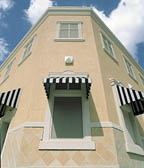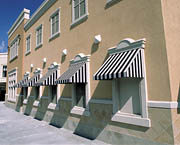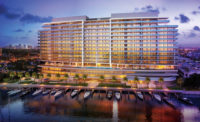

The decision to use EIFS in the construction of the new Centro Ybor entertainment complex came early on: There was simply no other way to economically replicate the ornate columns, cornices and other architectural details found in this historic section of Tampa, Fla., known as Ybor City.
Ybor (pronounced “EE-bore”) City sets itself apart from other sections of Tampa with its brick streets, ornate wrought iron lampposts, and elements of classical and Mediterranean architecture. Named after cigar maker Vicente Martinez Ybor, who moved his cigar factory from Key West to Tampa in 1886, Ybor City attracted Cuban, Spanish and Italian immigrants which made it the second-largest immigrant settlement in the South, after New Orleans. The immigrants worked in more than 140 cigar factories, producing over 250 million cigars a year. In its heyday, Ybor City was known as “the cigar capital of the world,” earning Tampa the reputation as “Cigar City.”
Meanwhile, craftsmen raising the buildings that became central to this Latin culture took the same pride in their work as the cigar makers did in theirs. Many of these structures have been renovated and are still in use today. A 115-year-old renovated cigar factory was converted into a mall filled with dining and retail establishments, and awaits yet another rebirth. Another century-old building has become home to The Ybor City Brewing Co., which brews its own brands of beer.
Today, Centro Ybor is seen as the crowning glory of the renaissance of Ybor City, which had deteriorated to the extent that vast portions were bulldozed to put in an Interstate. The area later evolved into an artist colony, and most recently, into a hot spot whose headbangers, vampires and ravers party on close to dawn.
The $450 million open-air complex, built to be a more family-oriented destination than the surrounding nightclubs and tattoo parlors, features upscale, one-of-a-kind restaurants, trendy shops, and a 20-screen state-of-the-art movie theater, where one can buy a martini to wash down one’s popcorn, if one is so inclined.
The two-story, red-brick Centro Espanol building—home to the first health maintenance organizations in the country, the immigrant mutual aid societies, where members could get low-cost health care—is the cornerstone of the Centro Ybor project. The challenge facing Centro Ybor developers was tying in the long-gone past with a modern, even futuristic, concept.
“The developers wanted to achieve what I guess you could call ‘the Ybor look,’” says Jonathan Graham, president of GPM Inc. in Tampa. GPM is a contractor with about 120 employees working throughout central and south Florida. They specialize in stucco synthetics, masonry and drywall. “There’s a lot of precast, along with the old brick, right now, but they didn’t want to go with the expensive precast. They would rather make the decorative areas and panels out of EIFS, which gave the impression that it was of precasting. Like the actual precast on other buildings, it blended well with the brick. They also wanted to give it a vibrant look, so the color was important.”
Graham says there were numerous cornices and large cornice caps that were originally made out of stone on the old buildings. These, and other decorative pieces originally made of stone, were reconstructed with EIFS on the new Centro Ybor section.
“The job, which came out to be about 75,000 square feet of EIFS, called for brick and EIFS subs right from the very beginning,” says Graham. “It was about 90 percent new construction and about 10 percent renovation, but it all had to tie in together and with existing architecture.”
“Certainly one of the challenges the architects faced is that Ybor is an old historic district,” says Courtney Roberts, vice president of Pleko Southeast Corp., based in Lakeland, Fla. Pleko’s Therm System (PB) polymer-based EIFS was used on the project. “Since it was obvious they wanted to give the historic district a consistent look, it was out of the question to put a big modern building down there. So a new structure had to be built, but it had to be in keeping with Ybor’s Spanish flair, which meant not only a whole lot of decorative EIFS work such as parapet caps, bands and columns, but a lot of colorful flatwork, as well.”
Roberts says the Therm System (PB) specified for the Centro Ybor project is formulated for the harsher Florida climate—meaning a lot of sun, heat and humidity.
“Our structure finishes are more flexible than the average EIFS finish, and withstand the elements better,” he says. “There’s a lot more polymer in it. That makes it more fade resistant, and definitely more flexible and water-resistant than the standard EIF system. It costs a few dollars more a bucket, but there’s a niche market for it with people who understand they’ll be saving money in the long run.”
Just minutes down the road from Ybor City, another area of Tampa is undergoing renovation, and here again, GPM and Pleko teamed up.
A $49 million complex of movies, restaurants and shops known as “The Shops at Channelside” are slated to open in early 2001. Tampa’s long-neglected Channelside District is the location of Tampa’s cruise ship terminal, and developers are hoping to take advantage of the 50 kinds of businesses the International Council of Cruise Lines says benefit from the industry. These, they say, range nationally, from air travel ($1.8
billion a year) to electrical industrial apparatus ($45 million).
Until The Shops at Channelside are open, cruise passengers wandering off the boat often commented on the lack of things to do while they were docked in Tampa. Most, it seems, had a little extra time on their hands, but didn’t want to get a cab to go into the city, just minutes from the terminal, and they didn’t want to get too far from the ship.
The $49 million movie/restaurant/
retail Shops at Channelside will, in fact, help link Ybor City with downtown Tampa. This link will include the Florida Aquarium, the Ice Palace (home of the Tampa Bay Lightning professional hockey team) and surrounding sports bars, and the Tampa Convention Center and new convention hotel. An electric trolley is planned to begin running between the Tampa Convention Center and Ybor City, with a stop at the aquarium, beginning in 2002.
In keeping with the party atmosphere, developers were looking for in the Shops at Channelside, 150,000 square feet of colorful EIFS was used in the all-new construction.
“They wanted to give the area a sort of an amusement park-type feel, something you might see at Disney,” says Graham. “They were looking for lots of different colors, lots of different shapes, lots of different elevations, recesses and protrusions. And the only thing that could have accomplished that economically was EIFS.”
In fact eight different colors were used over the heavy-gauge metal framing at Channelside.
“For Tampa, it’s really a new type of project,” says Roberts. “The concept is very familiar in Orlando. In fact, I call it the ‘Orlando’ look. It’s a whole EIFS system including columns and bands, and it even has the fake windows cut into the foam. This is all so common in Orlando but you hadn’t seen it much in Tampa up to this point.
“You can be so much more creative with EIFS. If you had to do all that detail work in brick and concrete and plaster, the cost would be so prohibitive, you would be left with a big rectangular building. But EIFS allowed the designers to liven this up, give it a fun, tropical theme—a Florida look. I think they succeeded.”


